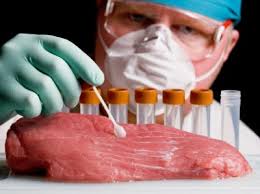We are frequently asked how long can meat stay in the freezer or fridge, can it be refrozen, and how long can it sit out. The FDA has clear guidelines and we encourage you to follow their recommendation. We’ve covered the questions in our FAQ and have links to the FDA guidelines in the article on How To Feed Fetching Foods.
Many people are very concerned about feeding raw. In fact, about raw meat in general. Some concerns are overblown and others are very legitimate. Handling raw meat correctly and knowing more about how to recognize it going bad is important to gain confidence feeding your kitty or pup.
There are three primary ways meat goes bad. They’re all recognizable and are obvious when meat’s bad. 1) Oxidation, 2) Enzymatic breakdown, and 3) Bacteria contamination.
When meat is left out the color can change from red or pink to a brownish color. Oxidation is when the meat turns brown. Oxygen reacts to chemicals in the meat, like iron, that turns the color (iron+oxygen = iron oxide, commonly known as rust). It also activates free radicals which causes the fat to deteriorate. This is one reason why we vacuum seal our products, to protect from oxidation. Usually safe to consume, the over oxidized portions of meat can develop an off-flavor, especially in the fats, in addition to looking ‘bad’.
Enzymes break-down proteins. They’re the component found naturally in meats that help clean your pet’s teeth when they eat raw food. Cooking/heat kills enzymes.
Enzymatic breakdown happens when the meat sits out at temperatures above freezing. The higher the temperature the faster the breakdown. It’s the same process used with aging meats (eg dry aging), making the meat more tender by controlling the meat’s temperature and thus the rate of enzymatic breakdown of the muscle tissue.
If you set a vacuum-sealed package (so there’s no oxidation or bacteria activity) of meat on your counter, it would take about a week before it became slush from the enzymes decomposing the contents. You can tell enzymatic actions are well underway by noting a softening and greenish discoloration of the meat due to tissue degradation of the complex compounds (carbohydrates, fats and protein).
Bacteria are not all bad. In fact, every time we eat we’re ingesting bacteria, contributing to our microbiome (bacteria in the gut that help us digest). Probiotics are helpful bacteria we eat to augment our microbiome. The microbiome is the community of microorganisms that live on and in us, especially in the gut. It’s often called the forgotten organ since it’s so helpful to our digestion and overall wellbeing.
Bacteria contamination typically comes from poor slaughterhouse practices when pathogens (bad bacteria) are introduced. Using high-end human-grade food gains the highest levels of sanitation and care during processing to reduce these threats*. Microbial spoilage causes a pH change, slime formation, structural components degradation, off odors like sulphur, and appearance change.
Fetching Foods uses vacuum sealed bags for our product to prevent bacteria and oxidation contamination. If there’s no oxygen, bacteria can’t grow. No oxygen and the meat can’t oxidize. Even unfrozen, room temperature, the food can be safe for a surprising period of time. Combine the vacuum sealing and temperature control and you have a product with high integrity, durability, and longevity.
When meat goes bad, you can easily see, feel, and smell it. Proper handling, packaging, and preservation techniques can improve the quality of meat and meat products, increasing their shelf life and overall durability.
*(We only use processors that we know and trust. We’re familiar with how the animals live, are treated, fed, and processed.)
REF: https://pdfs.semanticscholar.org/76c0/6ffbcdc508a8ed0ca363c6a496bfb765304e.pdf

In recent years, pet owners have become increasingly concerned about the quality and nutritional value of the food they feed their furry companions. One trend that has been gaining popularity is the use of hydrolyzed ...
Introduction As pet owners, we are constantly seeking ways to improve the health and well-being of our beloved furry companions. One aspect that has gained significant attention in recent years is the use of herbal ...
As we move through this holiday season and towards the new year, we’ve been stuffing our faces as we prepare to stuff our stockings! You might already be at the point where you are loosening ...